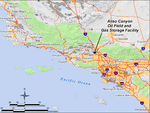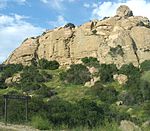Renaissance Summit
Communities in the San Fernando Valley
Renaissance Summit (also known simply as Renaissance or Renaissance at Porter Ranch) is a gated housing subdivision in the northwest San Fernando Valley of the city of Los Angeles, at the highest point in the Porter Ranch neighborhood. Its building and opening was championed by major local political figures in the 1980s and 1990s but was also an ongoing source of controversy in the area.
Excerpt from the Wikipedia article Renaissance Summit (License: CC BY-SA 3.0, Authors).Renaissance Summit
Via Madrigal, Los Angeles
Geographical coordinates (GPS) Address Nearby Places Show on map
Geographical coordinates (GPS)
| Latitude | Longitude |
|---|---|
| N 34.2967 ° | E -118.5739 ° |
Address
Via Madrigal
91326 Los Angeles
California, United States
Open on Google Maps






